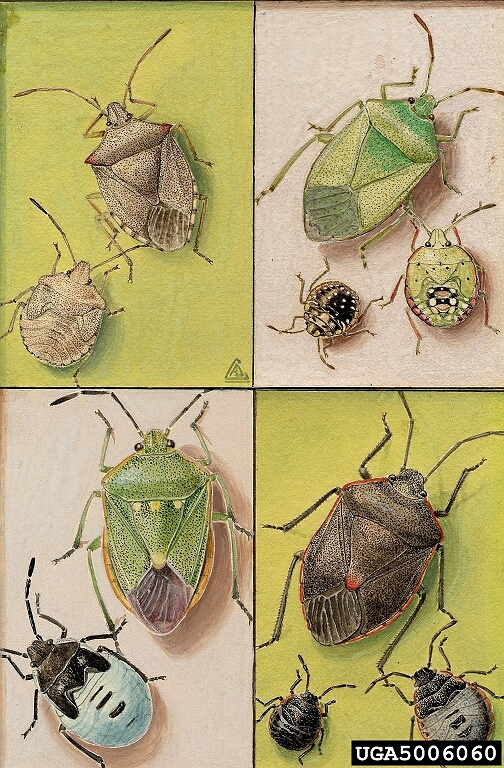- Pentatomidae
Taxobox
name = Pentatomidae

image_width = 230px
image_caption = "Acrosternum hilare"
regnum =Animal ia
phylum =Arthropod a
classis =Insect a
ordo =Hemiptera
subordo =Heteroptera
infraordo =Pentatomomorpha
superfamilia =Pentatomoidea
familia = Pentatomidae
familia_authority = Leach, 1815
subdivision_ranks = Subfamilies
subdivision =Aphylinae Asopinae Cyrtocorinae Discocephalinae Edessinae Pentatominae Phyllocephalinae Podopinae Serbaninae Stirotarsinae Pentatomidae Greek: "pente" (five) + "tomos" (a section) is a family of
insect s that includes some of the stink bugs andshield bug s.If disturbed, stink bugs will emit a pungent liquid, whose rancid almond smell is due to
cyanide compounds. Their antennae are 5-segmented, which gives the family its name. Their bodies are usually shield-shaped. The stink bugs have thick wing covers known as shields and they actually cover wings that the stink bug uses to fly.Many stink bugs and shield bugs are considered agricultural pest insects, because they can create large populations; they suck plant juices and damage crop production, and they are resistant to many
pesticide s. However, some genera of Pentatomidae are considered highly beneficial; the anchor bug, which can be distinguished by the red-orange anchor shape on the adult, is one example. It is a predator of other insects, especiallyMexican bean beetle s,Japanese beetle s, and other pestinsects.In the British Isles there are 33 species of shield bugs belonging to the super-family
Pentatomoidea , 32 of which are native and 1 which is considered to be newly naturalised.cite book| last = Evans | first = Martin | authorlink = | coauthors = Roger Edmondson | title = A Photographic Guide to the Shieldbugs and Squashbugs of the British Isles | publisher = WGUK | date = 2005 | location = Wakefield| id = ISBN 0-9549506-0-7 ] Of these 32 species, 17 belong in the family Pentatomidae.Identification features
The family characters include five-segmented antennae, a four-segmented beak and 3 tarsal segments. The body shape is generally shield-like when seen from above. The triangular scutellum is usually as long as the corium of the forewing.
Species include:
*Green shieldbug ("Palomena prasina")
*Brown marmorated stink bug ("Halyomorpha halys")
*Horehound bug ("Agonoscelis rutila")
*Forest bug ("Pentatoma rufipes")The unscientific name "stink bug" is sometimes applied to entirely unrelated species such as
Boisea trivittata , also known as the "boxelder bug ."ee also
*
Sunn pest Cited references
External links
* [http://www.cirrusimage.com/bugs_stink.htm Stink Bugs of North America - photos and information]
* [http://www.cirrusimage.com/bugs_stink_green.htm Green Stink Bug "Acrosternum hilare" - large format diagnostic photos, adults and nymphs]
* [http://www.cirrusimage.com/bugs_stink_cosmopepla_bimaculata.htm Stink Bug "Cosmopepla bimaculata" diagnostic photos]
* [http://www.david.element.ukgateway.net/bugs2shieldbugs2.htm Images of shield bugs]
* [http://www.ento.psu.edu/extension/factsheets/brownMarmoratedstinkbug.htm Brown Marmorated Stink Bug - Penn State Entomology Department Fact Sheet]on the
UF / IFAS Featured Creatures Web site
* [http://creatures.ifas.ufl.edu/veg/bean/green_stink_bug.htm "Acrosternum hilare", green stink bug]
* [http://creatures.ifas.ufl.edu/beneficial/a_grandis.htm "Alcaeorrhynchus grandis", a predatory stink bug]
* [http://creatures.ifas.ufl.edu/veg/bean/brown_stink_bug.htm "Euschistus servus ", brown stink bug]
* [http://creatures.ifas.ufl.edu/beneficial/e_floridanus.htm "Euthyrhynchus floridanus", Florida predatory stink bug]
* [http://creatures.ifas.ufl.edu/beneficial/a_grandis.htm "Halyomorpha halys", brown marmorated stink bug]
* [http://creatures.ifas.ufl.edu/veg/bean/southern_green_stink_bug.htm "Nezara viridula", southern green stink bug]
* [http://creatures.ifas.ufl.edu/beneficial/podisus_maculiventris.htm "Podisus maculiventris", spined soldier bug]
* [http://creatures.ifas.ufl.edu/beneficial/stiretrus_anchorago.htm "Stiretrus anchorago", a predatory stink bug]
* [http://creatures.ifas.ufl.edu/misc/bugs/black_stink_bug.htm "Proxys punctulatus", black stink bug]
Wikimedia Foundation. 2010.
